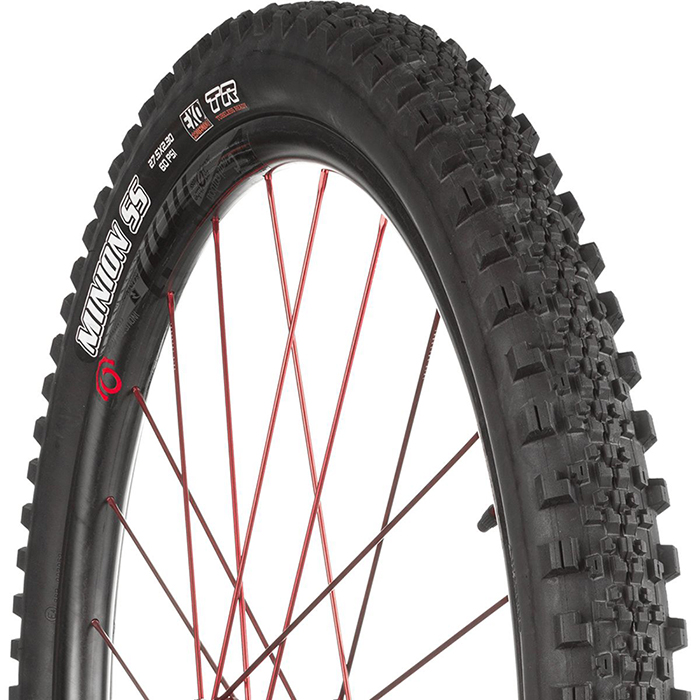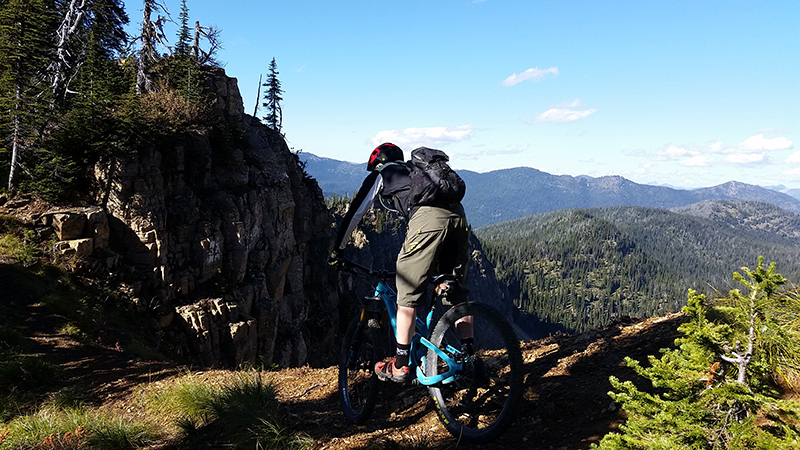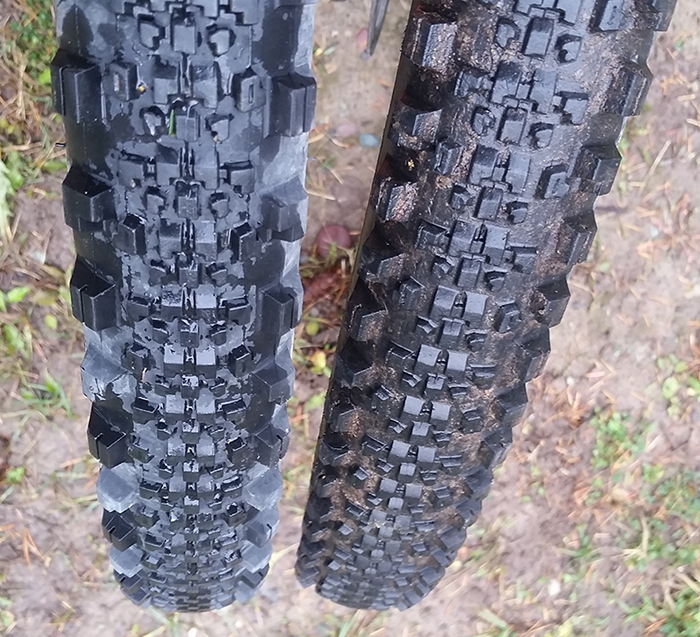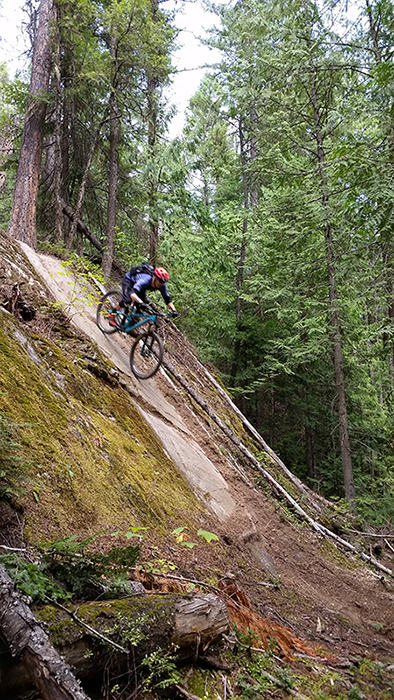
Maxxis Minion SS
Stated Width: 29” x 2.3”
Measured Dimensions (on a 23 mm internal width rim)
- Knob width: 55.5 mm
- Casing width: 54 mm
Casing: DoubleDown Casing
Compound: 3C Maxx Terra
Blister’s Measured Weight: 1026 grams
Mounted to: Yeti SB5.5
MSRP: $65
Reviewer: 5’9”, 155lbs
Test Locations: Montana, British Columbia
Days Tested: About 30 rides
While the Minion SS has been in Maxxis’ tire lineup for a little while now, they’ve quietly released a newly revised version. It’s still the same basic tire – a semi slick with substantial side knobs to help out with cornering, but those sideknobs have seen some revisions since the original version.
I’ve spent time on both the original version as well as the new version, and for the most part, I think Maxxis has made a significant improvement, and it’s one of my favorite rear tires for dry conditions.
Options
The Minions SS is available in a bunch of different sizes, including all three wheel sizes (26 / 27.5 / 29), with a few casing and compound options in each. Most of the Minion SS options are only available in the 2.3” width, but Maxxis does make a 27.5 x 2.5” version of the tire with a downhill casing that’s available in either the Supertacky or Maxx Grip compounds.

I rode the Minion SS in Maxxis’ Doubledown casing, which is one notch down from their full blown DH casing. The Doubledown casing is noticeably stiffer and heavier than the Exo casing, and might be overkill for a lot of riders, but it’s great if you’re having issues with casing durability, but you don’t want to fully commit to the weight penalty that comes with a DH casing.
Personally, I find it depends on where I’m riding, but I can usually get away with the lighter weight Exo casing. The Exo casing is also slightly more supple, so it seems to ride a little more smoothly and maintain traction a little better in some situations.
The dual compound used on all of the “trail” oriented 2.3” options has some harder rubber down the middle to help with durability, and some softer rubber on the side knobs to help with traction. I’ve found this compound to work pretty well – it holds up well, but it still hooks up in corners nicely. It’s obviously not as grippy as a supertacky compound, but it’s far more durable.
Tread Design
The center of the Minion SS is made up of small, tightly spaced knobs, most of which are ramped to reduce rolling resistance. They bear a little bit of similarity to the XC oriented Maxxis Race TT, but the knobs on the Minion SS are spaced even tighter. The braking edges are all squared off to retain a bit of traction while slowing down, but clearly the priority here was on a fast rolling design.
The side knobs are a different story entirely – they’re essentially identical to the side knobs on a Minion DHF. Alternating rectangular and “L” shaped knobs provide maximum cornering traction, and are designed to work at higher lean angles.
This is also the area where the new Minion SS has been modified. The original version had relatively large, spaced out side knobs. The new version’s side knobs are the same basic shape, but they’re a bit smaller, and they’re spaced closer together.

Mounting and Setup
I’ve run the Minion SS on a few different rims from DT Swiss, Enve, and Reynolds, and all of them set up tubeless without any issue. On some of the easier rims, I can get them to seat with a floor pump. I’m using my homebrew sealant, and I’m usually running them at around 28-30psi.
The Ride
In a straight line, the Minion SS is noticeably faster than any other tire that I would run on a trail bike. I’d say it’s not quite as fast as a full blown XC race tire, but it’s not too far off.
I’d also say the Minion SS could have been faster, but I was running it on rims that were too wide. I spent the most time with the SS mounted to a DT Swiss XM481, which has a 30 mm internal width. On that rim, the tire is very squared off and the side knobs are contacting the ground a bit, even when the bike isn’t leaned over. Both in terms of rolling resistance and cornering performance, I think the tire would work better on a narrower rim. I mounted up the tire on a 23 mm rim and it definitely had a slightly rounder profile (while still being relatively squared off) which I think would work better, but the sidewalls didn’t have the support that a wide rim offers. At a guess, a rim with an internal width of around 25-26 mm might be the optimal middle ground for this tire.
Cornering on the Minion SS is an exercise in commitment, with big rewards when you go for it. Coming into a corner and leaning in gradually, nothing happens. Or, more accurately, the tire breaks traction as soon as you start to lean it over. This is disconcerting at first, especially if you’re expecting it to behave more like a “normal” tire that breaks loose more gradually.
But, if you commit to the corner and lean the bike into it, great things happen. The side knobs engage, and once they do, they lock in hard. This tire will corner as hard as any other 2.3” tire on the market.
Like I mentioned earlier, the Minion SS has been revised recently. The old version, with large, widely spaced side knobs, would sometimes feel a bit squirmy in hard packed corners – it felt like the knobs were flexing a bit. The side knobs were also a bit taller than on the new, revised version, so on a wide rim, they would contact the ground even more (and thus slow the tire down). The flip side of those big side knobs was that, in soft dirt, the point where the tire would catch in a corner seemed a bit less abrupt. It’d still lock into a corner, but the spaced out knobs seem to let some dirt pass through, and the grip came on a little more gradually.

The new version of the SS is like a light switch – as the bike is leaned over, cornering traction comes on quickly, and once it’s there, it’s there. It takes some getting used to, but once you’ve learned the “grab” point for the tire, it’s pretty rewarding to flick the bike over and rail the shit out of a corner.
Unsurprisingly, the Minion SS doesn’t offer nearly as much climbing or braking traction as something like a Minion DHF or DHR II. Particularly in wet conditions, the SS packs up easily and gets pretty skatey. But in dry conditions where straight line traction usually isn’t at quite such a premium, I felt like it did just fine. I do, however, occasionally find myself letting the back end step out to the side just so I can get the side knobs engaged a bit more and get the tire to hook back up.
I’d say the SS rides somewhat similarly to the Highroller II in that it’s a fairly loose tire when it’s not leaned over, but once you commit to the corner, it does it’s job really well. The Highroller has noticeably more braking traction, but it also rolls slower than the SS.
There are some other semi-slicks that I’d like to compare the Minion SS to, but the only one I’ve spent much time on is the WTB Riddler. I’d say the Riddler rolls a smidge faster, but the Minion SS corners quite a bit harder.
NEXT: Durability, Bottom Line

Thoughts on a fast tire for a 35MM internal rim? Sounds like the Minion SS is too small.
Yeah, I’d say the SS wouldn’t work as well on a rim that wide. I’d take a look at the WTB Riddler. It’s rolls a bit faster than the SS, but definitely doesn’t corner quite as hard. But it comes in a 2.4, which should work better on the wider rim.
Having run it on a WTB ST i25 rim, I’d say that the cornering knobs being in constant contact with the ground doesn’t really go away until the rim internal width is within the 22.5-23mm range. The paved transfer sections i run seem to be contributing to the accelerated shoulder knob wear, but me being a fat arse and riding hard in rocky desert terrain is the rest of that explanation.
For dry terrain, there is a LOT to love about the pairing of a DHR2 and SS Minion combo, as the braking edges of the DHR2 help make up for the straight line braking traction deficit of the semi-slick, and once leaned into a turn they both play along nicely. My particular setup I’ve ran is an Asym i29 out front with the 2.4WT DHR2, and the narrower ST i25 out back with the 2.3 SS, and this is pretty good for four corners riding. I’m only about 400mi in beating on this tire, a non-trivial portion of that is paved surface use, but it’ll be toast in about that distance again. Been quite good for meeting expectations, and there are a few cases where the rear tire grip has notably out-stripped the front in some conditions (mostly slabby granite or outright hardpack).
I think they should be working on a 2.4-2.5 WT variant, and benchmark that on 29-30mm IW rims, as that’s basically the answer. I’m going to be replacing it with a Specialized Slaughter Grid, just because the corner knob drag would drive me nuts on a 30mm IW rim that I’m moving to… Might try the Riddler, but I can’t get those locally, and the 29×2.4 is a bit of an odd duck to carry… the Aggressor in DoubleDown might be worth it’s own look as well.
Thoughts on DHR 2 front and SS rear for Missoula area? Seems like they would play well together in fast, dry conditions.